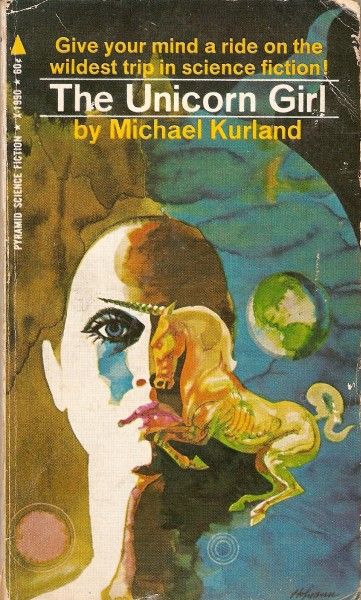Psychedelic SF Revisited
The Unicorn Girl (Greenwich Village Trilogy, volume 2)
By Michael Kurland

17 Apr, 2016
Because My Tears Are Delicious To You
0 comments
1969's The Unicorn Girl is the second book in what the ISFDB calls the Greenwich Village series; it’s a sequel to Chester Anderson's 1967 The Butterfly Kid. Rather oddly, it was written by Michael Kurland, not Anderson. One of the defining characteristics of this series is that no two books in it were written by the same author1.
What they do share is a cast made up of the authors’ friends, and a plot centering on the endless struggle of futuristic hippies to protect the world.
A year after dealing with the butterflies, the panicked teenyboppers, and the blue lobsters from space, Michael Kurland and friends have relocated to the West Coast. There Michael meets Sylvia, who is distraught over the loss of her unicorn Adolphus. Unicorns may be mythical, but anyone who ever lived in the Village is used to encountering odder things twice before breakfast. Rather than leave Sylvia to search on her own, Michael offers to help her.
Pausing only to draft close friend Chester Anderson into the search, the group sets off in quest of the missing Adolphus. What could go wrong?
BLIP!
Sylvia's friendship with Adolphus isn't Sylvia's only peculiarity; she thinks the year is 1936. Her circus arrived in San Francisco on a rail line that has not existed for six years and she hails from a Massachusetts Commonwealth that has had starflight for decades. That last detail explains why some of her co-workers are aliens. Extraterrestrial aliens.
Time travel might explain how a woman from 1936 ended up in 1980s San Francisco, but it would not explain the unicorn or the aliens. Not time travel of the usual sort, from the past to the present (or vice versa).
The unicorn questers begin to understand what is happening when they are displace into a new world populated by hyper-moralistic quasi-Victorians. The travelers have just begun to come to terms with their new circumstances when they are transported to yet another new world. This happens again and again: transfer, exploration, and transfer again.
Who is responsible? Unknown. The possibility of a violent death at the hands of a violent cross-timer? High and rising....
~oOo~
As is Nicoll tradition, I read this book well before the book to which it is a sequel. I liked it enough to snap up the 1980 reprint of The Butterfly Kid when I encountered it.
Readers familiar with pre-disco SF will notice a number of hat-tips to a variety of 1960s-era authors. The most prominent (and least ambiguous2) hat-tip is to Randall Garrett, whose Angevin Empire plays a significant role in the story. Given that Kurland cheerfully folds his friends into the story, it seems safe to guess that Kurland knew Garrett. As Kurland wrote two sequels to Garrett's Lord Darcy books


I would bet real money on my guess.
Like The Butterfly Kid, this is a comedy. Unlike The Butterfly Kid, it riffs on alternate history rather than alien invasion tropes. If I had read the Anderson, that might have come as a surprise but as it happens, my first exposure to Kurland (and the reason I snapped this up) was this novel.

The Whenabouts of Burr, is also a comedy involving alternate time lines, although the setting is post-Watergate, not everyone’s fave psychedelic era. Although I could not know it at the time, my expectations for Kurland's other books were based on a wildly misleading sample; alternate history is only a very small part of Kurland's oeuvre and it was just coincidence the first two books of his I read were both alternate history. In fact, of the more than two dozen novels Kurland has written, only The Unicorn Girl, The Whenabouts of Burr, and his two sequels to Garrett's Lord Darcy books are alternate history. His other books range from interstellar adventure to gas-lamp mysteries.
Somewhat atypically for the time, the two women in the group—Sylvia and Dorothy—manage to kick serious ass. The chivalrous Michael tries for kickass, but his first choice of weapon is a stick so rotten that it breaks when applied vigorously. Michael might see Sylvia as a Damsel in Distress, but Kurland does not see his eponymous character that way; he’s more like a Nerd in Distress.
This novel is exactly the cheerful light comedy it set out to be. Unlike the other two books in the series, it is still in print.
1: The third book, The Probability Pad, was written by magician Tom Waters.

It is the least known and hardest to find because it only had one printing, but I do own a copy.
2: I think Sylvia's home timeline may owe a debt to Frederic Brown's What Mad Universe.

